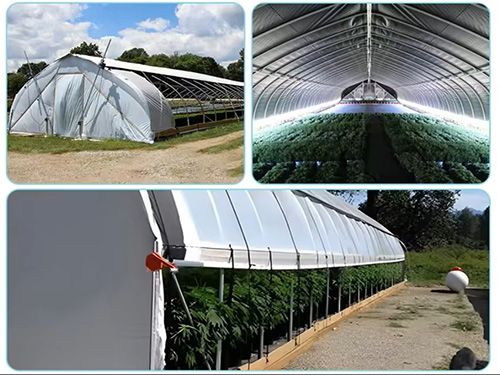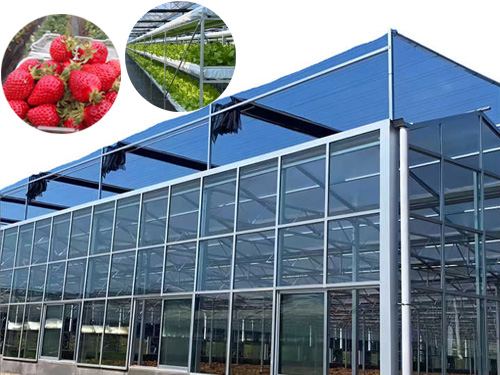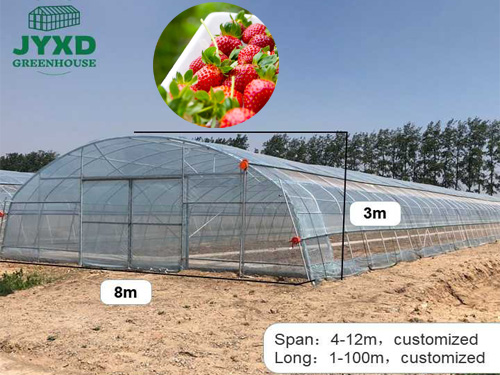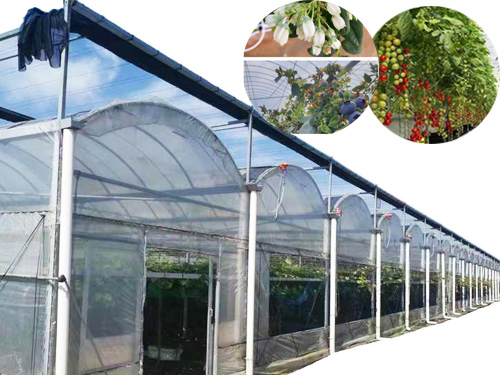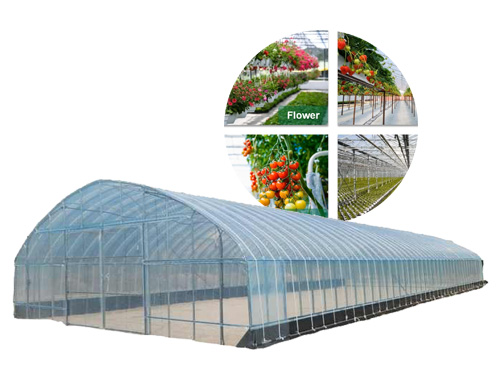NEWS DETAILS
NEWS INFORMATION
Managing Temperature Gradients in Greenhouses for Uniform Crop Growth
AUTHOR:jyxd-greenhouse DATE:2025-01-16 15:02:55 HITS:163
Temperature control is one of the most critical factors in greenhouse management. Maintaining a stable, uniform temperature ensures that plants receive the optimal conditions for growth, resulting in higher yields and healthier crops. However, in many greenhouses, temperature gradients—variations in temperature from one part of the greenhouse to another—can lead to uneven growth, stress, and reduced crop quality. This article will explore the importance of managing temperature gradients in greenhouses and discuss effective strategies to achieve uniform crop growth.
Why Temperature Gradients Matter in Greenhouses
Temperature gradients can occur in a greenhouse due to factors such as uneven heat distribution, varying sunlight exposure, and inadequate ventilation. These gradients can cause a variety of problems for crops, including:
· Uneven Growth: Plants in cooler areas may grow slower or less vigorously than those in warmer zones, leading to inconsistent yields.
· Stress on Plants: Temperature fluctuations, especially sudden changes, can stress plants, making them more susceptible to diseases and pests.
· Reduced Yield Quality: Inconsistent temperatures can affect plant development, resulting in poor-quality crops with irregular shapes, sizes, and colors.
· Increased Energy Consumption: If certain areas of the greenhouse are too hot or too cold, more energy may be required to maintain the desired temperature, increasing operational costs.
Managing temperature gradients is essential for creating a consistent environment that supports healthy, uniform crop growth across the entire greenhouse.
Strategies for Managing Temperature Gradients
There are several strategies that greenhouse operators can implement to minimize temperature gradients and maintain uniform conditions for plant growth. These methods focus on improving heat distribution, enhancing ventilation, and utilizing technology to maintain a consistent temperature throughout the greenhouse.
1. Improved Insulation and Glazing Materials
The materials used in the construction of the greenhouse play a significant role in regulating temperature. Proper insulation helps prevent heat loss during colder months, while transparent glazing materials maximize the amount of sunlight entering the greenhouse. Choosing high-quality glazing materials can significantly reduce temperature fluctuations, making it easier to maintain a consistent internal temperature.
· Polycarbonate Panels: These panels are effective in trapping heat and reducing heat loss while still allowing sufficient light penetration.
· Double Glazing: Double-glazed panels offer improved insulation compared to single-pane glass, helping to stabilize the internal temperature.
· Thermal Screens: These screens can be used to trap heat during the night, reducing the need for additional heating systems.
By optimizing insulation and glazing, greenhouses can reduce temperature gradients and create a more stable growing environment for crops.
2. Air Circulation and Ventilation
Proper air circulation is essential for distributing heat evenly across the greenhouse. Stagnant air can lead to localized temperature differences, with some areas becoming too hot or too cold. Adequate ventilation helps to control humidity, temperature, and airflow, ensuring that all plants receive a consistent amount of light and heat.
· Exhaust Fans: These fans help expel hot air and maintain a stable temperature by drawing in cooler air from outside.
· Circulation Fans: Installing circulation fans throughout the greenhouse helps distribute heat evenly, reducing the formation of temperature gradients.
· Automatic Ventilation: Automated systems that open and close vents based on temperature readings can help regulate airflow and ensure even heat distribution.
By ensuring proper ventilation and air circulation, greenhouses can prevent temperature imbalances and maintain an optimal growing environment.
3. Climate Control Systems
Advanced climate control systems can help greenhouse operators maintain a uniform temperature by automatically adjusting heating, cooling, and ventilation based on real-time environmental data. These systems are particularly beneficial for larger greenhouses where manual temperature management may not be sufficient.
· Smart Thermostats: These devices can be programmed to maintain a specific temperature range, ensuring that the entire greenhouse stays within an optimal range for plant growth.
· Automated Shade Systems: In hot climates, automated shade systems can be used to reduce heat buildup by blocking excessive sunlight during the hottest parts of the day.
· Hydronic Heating Systems: These systems use water pipes to distribute heat evenly across the greenhouse, providing a consistent temperature across the space.
By utilizing advanced climate control technology, greenhouse operators can minimize temperature fluctuations and create a stable, uniform environment for crops.
4. Use of Thermal Mass
Thermal mass refers to materials that can absorb and store heat during the day and release it at night. Incorporating thermal mass into greenhouse design can help reduce temperature gradients by stabilizing fluctuations in temperature throughout the day and night.
· Stone or Concrete Floors: These materials can absorb heat from the sun during the day and release it slowly at night, helping to maintain a consistent internal temperature.
· Water Tanks or Walls: Water has a high thermal mass, so using water tanks or walls can help regulate temperature by storing heat during the day and releasing it during the night.
The use of thermal mass can reduce the need for external heating systems and provide a more consistent temperature throughout the greenhouse.
5. Zoning the Greenhouse
In larger greenhouses, it may be necessary to zone the space based on the temperature requirements of different crops. For example, some plants may thrive in cooler areas, while others require warmer conditions. By creating different temperature zones within the greenhouse, operators can optimize the environment for each type of plant.
· Cooling Zones: Areas with more heat-sensitive crops can be placed near ventilation openings or cooling systems.
· Heating Zones: Crops that require more warmth can be placed near heating systems or thermal mass materials.
Zoning allows for more precise temperature management and ensures that each plant variety receives the optimal conditions for growth.
Monitoring Temperature Gradients in Greenhouses
Effective management of temperature gradients relies on constant monitoring and adjustments. Greenhouse operators should use temperature sensors and climate monitoring systems to keep track of temperature variations across the space. Real-time data allows for prompt intervention if temperature gradients become too extreme, preventing potential damage to crops.
· Temperature Sensors: Placing temperature sensors at different locations throughout the greenhouse helps track temperature fluctuations in various areas.
· Climate Control Software: Integrating temperature data into a centralized control system allows operators to make adjustments quickly and efficiently to maintain a stable environment.
Regular monitoring ensures that temperature gradients are kept in check and that the greenhouse remains an optimal environment for plant growth.
Conclusion
Managing temperature gradients in greenhouses is essential for promoting uniform crop growth and ensuring high-quality yields. By implementing strategies such as improved insulation, enhanced ventilation, climate control systems, and the use of thermal mass, greenhouse operators can minimize temperature fluctuations and create a stable environment for plants. Monitoring temperature regularly and using advanced technologies will allow operators to maintain optimal conditions throughout the greenhouse. With careful temperature management, greenhouse operators can achieve better crop uniformity, healthier plants, and more efficient use of resources.
Hebei Juyou Xinda Greenhouse Facilities Co.,Ltd.
Copyright © 2024-2025 https://www.jyxd-greenhouse.com. All Rights Reserved Hebei Juyou Xinda Greenhouse Facilities Co.,Ltd.Copyright





 Current Location:
Current Location:


